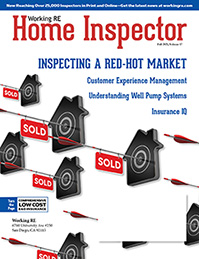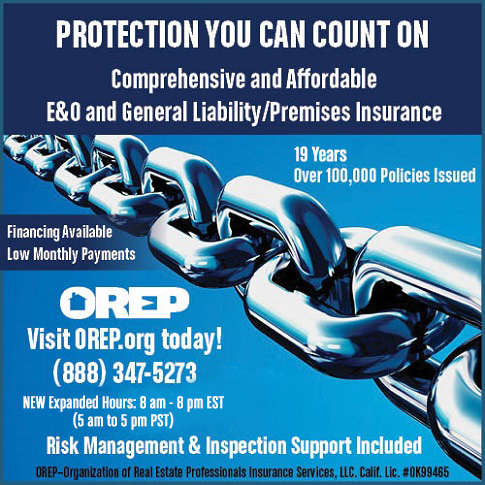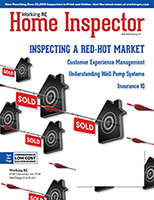 | > E&O/GL Insurance for Home Inspectors Competitive Rates, Broad Coverage, Free Risk Management, online inspection support for tough questions, discounts on education and more… Professional Coverage, Competitive Pricing Shop OREP today! |
Importance of Customer Experience Management
by Paul Zak, President of America’s Call Center
You own a home inspection business. Congratulations! You are a rare individual representing less than 10% of the U.S. working population who is taking the risk to own their own business. It is not easy being a business owner, but it can be an extremely rewarding experience for you and those you help with your business on a day-to-day basis.
You also chose a very competitive industry tied to the real estate market. Depending on where you live, it might only require a simple business license to start a home inspection business. Even in licensing states, the barriers to entry are relatively low when compared to other businesses. According to IBIS World, there are over 32,000 inspection businesses employing almost 50,000 inspectors. This includes sole proprietors, multi-inspector firms and franchises. The good news is that most home inspection transactions are at a local level. The not-so-good news is that, at a local level, you might be competing against both well-established inspection businesses as well as the newcomers hoping to score big by lowballing prices (which is not good for anyone in the industry).
Real Estate: Not Following Typical Cycles
In addition to a competitive home inspection industry, we have a non-traditional real estate market, where inventory has been at record lows for a considerable amount of time. Add a pandemic on top of the seasonal market cycle and many regions are seeing an even lower inventory—new housing starts are well above median home prices and a shortage of low-income and affordable housing. This can make it very difficult to predict what is next for the housing market! Despite all of that, 2021 was a record year for many businesses while others had to shut down. While there is still expected to be a lot of volatility in the market, 2021 is projected to see existing home sales up seven percent and single-family home housing starts up nine percent (https://www.realtor.com/research/2021-national-housing-forecast/). IBIS World is forecasting that 2021 will end with an over eight percent increase in home inspections over 2020.
What’s going to happen in 2022? Nobody has a crystal ball, but Freddie Mac is predicting that while home price increases will moderate or slow in 2022, home purchase mortgage originations will increase from $1.8 trillion (2021) to $1.9 trillion, with the number of home sales transactions remaining relatively flat at 6.9 million. If that prediction holds true, it means 2022 should see a similar number of home inspection transactions as 2021.
Competitive Landscape
2022 will see a potentially flat market, coupled with new inspection businesses starting in most regions along with some churn with your agent/customer base. These factors could have a significant impact on your bottom line if not anticipated. If you have an established business plan and are hitting all your business goals, great! If not, there are ways to improve.
There are several aspects of your business you should evaluate to see if they are at the level you would expect:
• Branding – Do you have a personal brand or a business brand? Is the messaging clear, and concise? Do people know your company and what it stands for?
• Business Development and Marketing – Are you doing regular agent and customer outreach? Are you engaged online?
• Lead and Sales Management – Are you educating clients, booking and upselling your services at the highest possible level?
• Inspections – Are there opportunities to increase efficiencies with your existing systems?
• Customer Experience Management – What are the experiences for the agents and clients who engage your company? Are you considering the experience from before they reach out to you to well past the inspection report and summary?
The rest of this article is going to focus on one aspect of your business that can have a tremendous impact: Customer Experience Management.
Importance of Customer Experience Management (CXM)
You may have seen some of the following:
• 80% of customers say the experience a company provides is just as important as its products or services – McKinsey & Company.
• 70% of buying experiences are based on how the customer FEELS they are being treated – McKinsey & Company.
• 67% of customers say they would definitely be willing to PAY MORE for a great customer experience – McKinsey & Company.
• 51% of customers will never do business again with a company after just one negative experience – Forrester Research.
• 33% of Americans say they will consider switching companies after just a SINGLE INSTANCE of poor service – American Express 2018 Customer Service Study.
How you treat your customer, from the moment they first contact you and throughout the entire experience, is paramount in not only retaining your agents and clients but is critical to growing your business. In today’s world, it is what separates you from the other inspectors around you. Assuming you already have a solid marketing plan in place, it can be argued that CXM is now one of the most important business growth tools a business owner can deploy. Controlling and managing the customer experience from the very first call (when they are making the decision to use your services) and beyond will make for a happy client, which will translate into a happy agent, which will turn into more referrals, increased positive reviews and more!
What is Customer Experience Management (CXM)?
CXM has been defined as: The discipline of understanding customers and deploying strategic plans that enable cross functional efforts and customer-centric culture to improve satisfaction, loyalty and advocacy. (Gartner.com)
Stated more simply…
• Customer Experience (CX) – The perception of your customer of their interactions with your company.
• Management (M) – The process of identifying how well (or not) your company is meeting the customer expectations with each customer interaction and putting plans in place to maintain areas that are currently positive and improve areas that are not.
(story continues below)

Compare the cost of E&O in 5 min.
(story continues)
Perception is a key word here. You’ve heard the adage “Perception is Reality” and that is very true in this industry. You may believe your customers have the best customer experience, but you really don’t know unless you ask and get honest feedback. And that perception is across all aspects of your business. The customer is building a perception of your business and your brand from the moment they hear about you—whether from an agent, a website search, or that first call. Does that first impression set the stage for the rest of their experience?
For example:
• Do your agents say, “You need to give XYZ Inspections a call, they will take great care of you!”?
• Does your website provide them with a great experience, or overwhelm them with clutter and details?
• When their call is answered after a few rings, does a friendly voice greet them, giving the time to answer all their questions about one of the biggest purchase decisions they may be making in their lives?
And it goes on from there. Are you focused on delighting the customer at every step of the process? Are your marketing materials friendly and engaging? Are you handling leads, offering your services and booking inspections in a helpful, easy manner? Is handling special requests a non-issue? After the inspection, how would you describe the reaction of your customer? How are you addressing questions or concerns they may have? What are you doing post-inspection to make sure the agent and client received the best possible experience?
How to Develop a CXM Strategy
Here is a four-step process to help you develop a CXM strategy.
1. Understand Your Customer
2. Create a Customer Journey Map
3. Develop an Emotional Connection
4. Capture Customer Feedback
Understand Your Customer
There are several ways to better understand your customers. One of the best is to consider the different types of customers you have experienced, so you know how to market to them. Typical profiles include the first-time homebuyer, the down-sizer, the up-sizer, the investor, etc. Write them down, then create “personas” for them. A persona is a fictional representation of the customer based on what you know about them. A first-time homebuyer might be “Melinda Millennial, who saved up enough money for a down payment, has a steady job and two dogs, and is nervous about home ownership.” Once you capture some of the key characteristics you can tailor your marketing accordingly.
Create a Customer Journey Map
Here is where you want to capture:
• The Buying Process
• User Actions
• Emotions
• Pain Points
• Solutions
There are multiple templates on the web that you can select and tailor to your needs, the important thing is to capture all the different areas where the customer interacts with your “brand,” how they move from one experience to another (initial contact, booking, delivered inspection, post-inspection follow-up, etc.) and what they experience at each step. This may feel like a lot of work that you inherently “know,” but the exercise is well worth the effort. You’ll probably be surprised at the new insights it will bring to your business and brand.
Develop an Emotional Connection
This can be challenging, especially during a pandemic. Still, at the most basic level, when a client or agent is interacting with you, your business and your brand, you want them to feel:
This person/brand/company is honest, has integrity, and I can trust that they will do their best for me throughout the entire process.
If they are not feeling a connection, develop an approach that will get you there. Brands that gain that reputation will be the ones experiencing the growth.
Capture Customer Feedback
Research from Bain & Company shows that 80% of companies believe they are providing great customer service. Only eight percent of their customers agree with them! That’s a big gap. How do you capture customer feedback?
• Send a follow up email
• Initiate surveys via text/SMS
• Create physical survey forms
• Conduct customer interviews
• Monitor social media channels
• Offer incentives for feedback
• Host social media contests
• Use feedback monitoring sites
• Use a reputation management service
• Reach out to agents who have stopped using you
Bottom line, if you are not asking for customer feedback on a regular basis you probably don’t have a good idea as to what they are really thinking.
Conclusion
Customer Experience Management will require both thought and effort, but once you have a system in place the benefits will far outweigh any costs. And you are not alone—everyone associated with your brand, including your inspectors, office staff and partners, has a role to play and can help with the ongoing efforts. In the end, if you have a brand that is perceived to be delighting its customers, you will see more business, more revenue and more satisfied agents and clients.
About the Author
Paul has been President of America’s Call Center since 2003. As a respected leader, national speaker, and true innovator, Paul continues to set a standard for excellence in the inspection industry. He holds a B.S. in Chemical Engineering from University of Rochester as well as a Masters of Business Administration (MBA) from University of Colorado Denver.
OREP/WRE Coronavirus Discussion and Resource Page
Coronavirus: National Home Inspector Survey
Note: The Fall 2021 issue of Working RE Home Inspector is mailing now to over 25,000 home inspectors nationwide. OREP Insureds enjoy guaranteed delivery of each print magazine and many more benefits.


